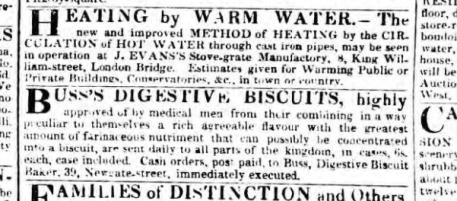

|
 Now a semi-sweet medium-to-high bake biscuit of sweetened and salted coarse wholemeal wheat flour. Typically 2¾ins diameter x 1/4ins thick, impressed with two rings of small indented dots and the word ‘DIGESTIVE’, but occasionally encountered in other shapes.  Digestive Biscuit of the (correct) traditional form www.hillbiscuits.com The term ‘digestive biscuit’ is known from the early 19th Century, when it was applied to a range of different biscuits claimed to aid digestion. The modern form of Digestive based on coarse brown wheatmeal can’t accurately be traced to any one baker, but seems to have gradually evolved over the years notably via the eariler Abernethy Biscuit The earliest record of the term ‘Digestive Biscuit’ we can find is an advertisement in the ‘Manchester Courier and Lancashire General Advertiser‘ of Saturday 19 September 1829 where “J. Hutchinson, the original introducer and sole proprietor of Abernethy’s celebrated Digestive Biscuits … takes this opportunity of cautioning his friends against imposition. These biscuits, when genuine, and taken regularly by families, have the good property of keeping the body in a regular state, and in a great measure supersedes the necessity of having recourse to medicine. Sold genuine, in pound packages, sealed at each end, only at the new Confectionary Establishment, 69, bottom of King-street, Manchester.” – though this clearly refers to the type of somewhat less coarse digestive invented by the English surgeon John Abernethy (1764-1831).  Morning Post, 24 February 1836 ‘Buss’s Digestive Biscuits’, advertising in the Morning Post of 24 February 1836 (just underneath an advert for the astonishing new central heating) claim that their biscuits have a “the greatest amount of farinaceous nutriment that can possibly be concentrated into a biscuit”, so may well have been like modern ones. But Hunley and Palmers specifically equate ‘Digestive Biscuit’ with Bath Olivers, while other makers promote a type of arrowroot biscuit. William Hill, “Biscuit maker to the queen” of Bishopsgate Street in London offered, in 1854, a ‘Brown Meal’ Digestive Biscuit, which was clearly separated from other types of ‘digestive’ biscuit and may well be the precursor of the modern form. It is not clear if this William Hill is connected to the present-day Hill’s Biscuit Company.  Original Receipt from ‘The Bread And Biscuit Baker’s And Sugar-Boiler’s Assistant‘ by Robert Wells, 1890 (Wells 1890) Original Receipt from ‘The Bread And Biscuit Baker’s And Sugar-Boiler’s Assistant‘ by Robert Wells, 1890 (Wells 1890)70. – Digestive Biscuits. Take equal parts of fine flour and wheat-meal flour and mix them together to 5 quarts of milk and water. Use 2 1/2 lbs. of butter and 2 ozs. of German yeast. Rub the butter in the flour, make a bay, pour in your liquor and yeast. Mix the whole into a dough, break it a little, and put it in a warm place to prove. After it is light enough, break it quite smooth and clear, roll it out in a sheet one-eighth of an inch in thickness and cut out your biscuits. As soon as the biscuits are cut out bake in a hot oven. 71. Another way. – 5 lbs. of granulated wheat meal, 1 lb. of butter, 1/4 lb. of sugar, 1/4 lb. of ground arrowroot, 4 eggs, 1 quart of milk, 1/4 oz. of carbonate of soda. These are mixed up in the usual way, pinned out and cut with a small round cutter, docked and baked in a moderate oven. 82. – Digestive Biscuits. 5 lbs. of wheat meal, 1 lb. of butter, 4 ozs. of sugar, 4 eggs, 1/4 oz. of carbonate of soda in 1 quart of water. Rub the butter in the wheat meal, make a bay, add the sugar, eggs, and soda; mix well together, add the water, and take in the wheat meal. After making it into dough, take about 2 lbs., roll it out into a sheet the thickness of a penny; take it on the pin again, and roll it on to a piece of cloth spread on the table; cut them out with a small oval cutter, put on tins well cleaned but not greased, and bake in a cool oven. The Great Digestive Biscuits Shipwreck of 2008 On 31 January 2008 the cargo ferry MV Riverdance ran aground at Blackpool, spilling her cargo of thousands and thousands of packets of chocolate digestive biscuits along a five-mile stretch of Lancashire coastline.  The Blackpool Digestive Shipwreck of 2008. Image: Victoria Hughes    |
|
MORE FROM Foods of England... Cookbooks ● Diary ● Index ● Magic Menu ● Random ● Really English? ● Timeline ● Donate ● Royalty ● English Service ● Food Map of England ● Lost Foods ● Accompaniments ● Biscuits ● Breads ● Cakes and Scones ● Cheeses ● Classic Meals ● Curry Dishes ● Dairy ● Drinks ● Egg Dishes ● Fish ● Fruit ● Fruits & Vegetables ● Game & Offal ● Meat & Meat Dishes ● Pastries and Pies ● Pot Meals ● Poultry ● Preserves & Jams ● Puddings & Sweets ● Sauces and Spicery ● Sausages ● Scones ● Soups ● Sweets and Toffee ● About ... ● Bookshop ● Email: [email protected] COPYRIGHT and ALL RIGHTS RESERVED: © Glyn Hughes 2022 BUILT WITH WHIMBERRY |